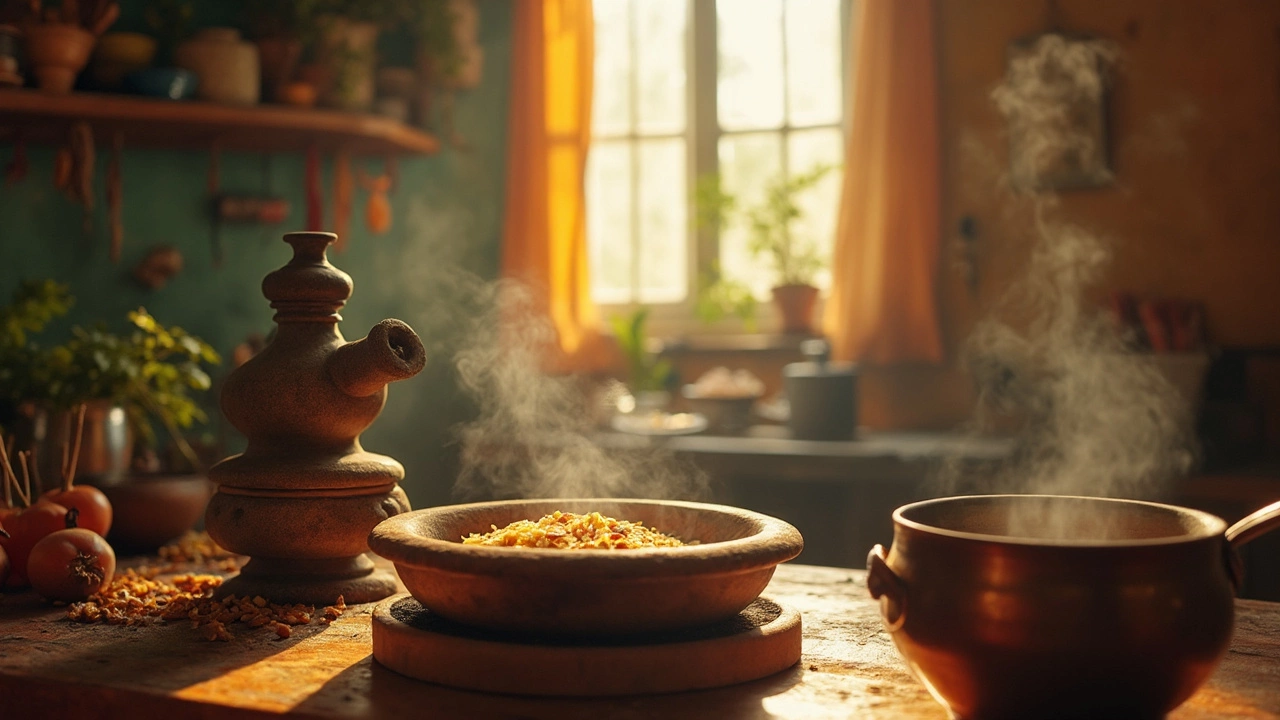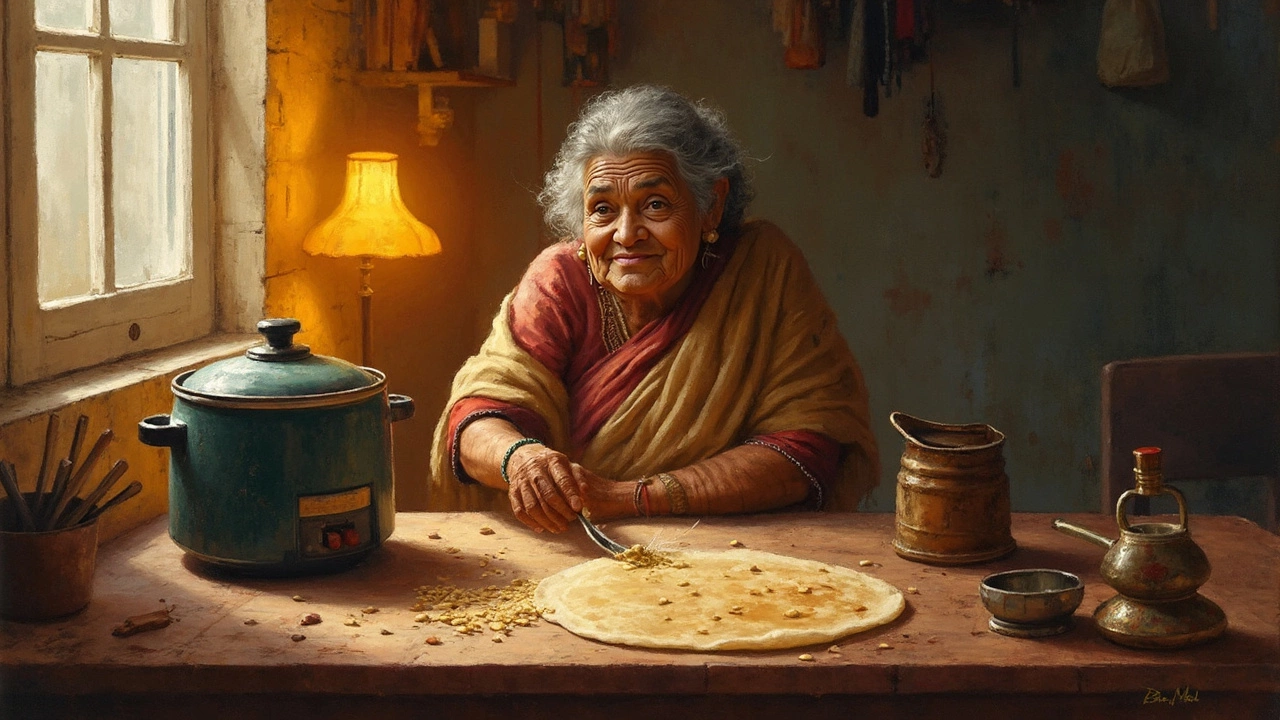No Yeast? No Problem: Quick Tips to Ferment Dosa Batter
 Feb, 13 2025
Feb, 13 2025
So, you're craving those golden, crispy dosas but you've just realized you're out of yeast. No worries! Tradition has it that yeast isn't even part of the original dosa-making process.
First off, let's talk about temperature. A cozy environment can be your best friend here. If you have a sunny spot in your kitchen or a warm oven (turned off, of course!), you've got yourself a natural incubator. Just wrap your batter container in a towel and let it sit in this warm haven. Want to speed things up even more? Your oven's light can gently raise the temperature just enough without cooking the batter.
Also, consider adding a little kick to the process with some fenugreek seeds while soaking your rice and lentils. Not only do they give a nice aroma, but they also tend to boost fermentation. Plus, they’re great for digestion. Sounds like a win-win, right?
- Understanding the Basics of Dosa Fermentation
- Why No Yeast: Traditional and Health Insights
- Increase Fermentation Speed with Temperature
- Using Ingredients for Better Fermentation
- Timing Matters: The Soaking and Blending Process
- Test and Taste: Knowing When Your Batter is Ready
Understanding the Basics of Dosa Fermentation
Dosa, that scrumptious crispy pancake from the South Indian kitchen, owes its unique texture and taste to the magic of fermentation. So, what's going on in your bowl of dosa batter? It's a natural process where good bacteria break down the sugars present in the rice and lentils, transforming them into carbon dioxide and acids. This not only puffs up your batter but also gives it that tangy, flavorful kick!
But let’s face facts, getting it right without yeast can be tricky if you don't know what you're doing. The traditional mix of parboiled rice and urad dal (black gram) acts as a natural catalyst, teaming up with the right conditions—like warmth and time—to deliver a perfect batter ready for the pan.
Natural Partners: Rice and Urad Dal
These two ingredients are not just chosen for their taste. Unpolished rice has something called phytic acid, and urad dal is rich in proteins that help drive fermentation. So, if you’re new to making dosa, stick to the classics.
Room Temperature and Patience
Ideally, your batter should sit at room temperature for about 8-12 hours. The warmer it is, the faster things happen. If it's a chilly day, don't worry—wrap the bowl with a warm cloth or just place it inside an oven with the light on. Maybe even set it on top of the fridge where warmth rises naturally!
Here’s a quick look at what typically happens during fermentation:
| Hours | Activity |
|---|---|
| 0-4 | Initial soaking and resting. Little activity. |
| 5-8 | Noticeable rise and slight sour aroma. Bacteria active. |
| 9-12 | Full fermentation with maximum rise and flavor. |
The fermenting dosa process without yeast captures the essence of traditional cooking, giving it not just taste but also enhancing the nutritional profile. Get these basics right, and you’ll have perfect dosas sizzling in no time!
Why No Yeast: Traditional and Health Insights
Using yeast in dosa batter isn't exactly traditional. Our grandmothers likely never heard of it either. The classic method relies on natural fermentation, which not only respects age-old practices but enhances the batter's nutritional value. This feels especially important in the fast-paced world where we sometimes overlook our cultural roots.
Fermentation without yeast harnesses naturally occurring bacteria in the air and from the rice and lentils to do the job. These bacteria break down food components, making it easier for our body to digest. So, it's not just about sticking to tradition—it's about health too!
Health Benefits
Besides being a nod to tradition, naturally fermented dosa batter is packed with probiotics. These good bacteria are fantastic for gut health, helping in digestion and boosting your immune system.
Fermentation increases the bioavailability of nutrients like vitamins and minerals. Did you know that enzymes produced during fermentation break down anti-nutrients in rice? This makes minerals like iron and zinc more accessible to your body.
Keeping It All Natural
The key is in simplicity and patience. By avoiding yeast, you reduce the likelihood of allergies or digestive issues some might face with artificial additives. Plus, the flavor you get from natural fermentation is second to none. Slightly tangy, with a hint of earthy richness—it's what makes dosas irresistible.
If you think fermented foods are crucial for healthy living, you wouldn't be alone. According to recent stats, about 70% of nutritionists recommend incorporating naturally fermented foods into a daily diet. And dosa, being a staple for many South Indian families, fits right in!
Increase Fermentation Speed with Temperature
Attempting to get the perfect dosa batter without waiting forever? Temperature is your best buddy! It’s like playing matchmaker, finding that sweet balance between heat and time.
Find the Right Spot
Kitchens have warm spots and they’re quite handy when you're dealing with fermentation. Think about the top of your fridge or a cozy cabinet near the stove. These can naturally be warmer than the rest of your kitchen.
The Oven Light Trick
Oven light is not just for illuminating your baking escapades. Switching on the oven light (without turning on the oven itself) creates a gentle heat, just enough to accelerate the fermentation of your dosa batter. Simply place the covered bowl inside, and let the magic happen.
Embrace the Thermos
An insulated flask or thermos surprisingly works wonders for quick fermentation. Pour your batter into one of these, seal it well, and leave it at room temperature. This method traps all the necessary warmth and speeds up the process significantly.
Winter Woes? Time for a Heating Pad
During chilly spells, a heating pad can be a lifesaver. Set it on a low setting and place it beneath your batter container. Remember, it shouldn't be hot—just warm enough to mimic a summer day.
Quick Tips
- Avoid direct sunlight: While warmth is good, direct sunlight can kill those helpful bacteria.
- Check regularly: Once the batter starts bubbling and increases in volume, it’s ready to be made into delicious dosas!
With these clever temperature tweaks, you'll have beautifully fermented dosa batter in no time. Just think about what you'll do with those saved hours!

Using Ingredients for Better Fermentation
To achieve quick dosa batter fermentation without yeast, it’s crucial to focus on the right ingredients. Some ingredients do more than just add flavor; they act as natural boosters for the fermentation process.
Fenugreek Seeds: The Unsung Hero
These tiny seeds might look humble, but they pack a punch. Soak a few tablespoons with your rice and lentils. Fenugreek seeds not only enhance the taste, but they also improve the batter's texture and speed up fermentation. Add about a teaspoon for a regular batch; trust me, these seeds make a big difference.
Poha for Faster Action
Flattened rice, or poha, is another ingredient that can work wonders. Mixing poha with your rice, usually in equal parts, adds lightness to the batter, making your dosas crispy and quicker to cook. Plus, poha soaks up water, which helps fermentation kick into gear faster.
Yogurt, When in Need
A small amount of yogurt can introduce friendly bacteria, boosting fermentation. If your climate is particularly cold or you’re just running out of patience, a tablespoon of yogurt could be your secret weapon. Just don't overdo it; too much can overpower the batter’s flavor.
Rice and Lentil Ratio: Balance is Key
The ideal ratio of rice to urad dal (black gram) is crucial—commonly, 3:1 works well. This balance provides the right consistency and helps your fermentation journey run smoothly. If you’re experimenting with alternatives like brown rice or quinoa, you may need to adjust the soaking time or even add extra ingredients to get the batter to behave as it should.
In short, the combination of these staple ingredients with a bit of know-how can elevate your batter from meh to marvelous in no time. So next time, mix those ingredients smartly and watch your dosa rise to perfection without a hint of yeast!
Timing Matters: The Soaking and Blending Process
Alright, let's dig into why timing is a big deal when it comes to soaking and blending your dosa batter ingredients. We all know that the magic begins with rice and lentils, but did you know that soaking them the right way can make or break your fermentation process?
Soaking: The Starting Point
You'll want to soak your rice and urad dal separately for about 4 to 6 hours. Some folks even let it sit overnight if they're planning an early breakfast. Why separate? Because each ingredient has its own unique soaking needs, and combining them can affect fermentation speed. Add a teaspoon of fenugreek seeds to the dal for an added boost. They'll help with the fermenting and also amp up the nutritional value.
Blending: Getting That Smooth Batter
Next up is blending. You're aiming for a batter that's not too thick but also not overly runny. The key is to use cold water when blending; this keeps the grinding temperature low, which is crucial for good fermentation. Start by grinding the dal first until fluffy and smooth, then do the rice into a slightly coarser texture. Mix them well, and don't forget the salt! It may not seem important, but salt plays two roles: it helps in fermentation and brings out flavors.
Optimal Fermentation Conditions
Once mixed, it's all about patience and keeping the environment right. Place the mixed batter in a container that allows room for rising. Your average kitchen, hopefully warm-ish, is just fine. During cooler months, you might need to do some improvisation—like placing it near your stove if you’re cooking. This little trick brings heat and helps the fermenting dosa batter faster.
All these steps are part of mastering the timing for making dosas timely and tasty. Remember, practice makes perfect, so don't stress if your first batch is not exactly what you expected. Keep experimenting with your environment and techniques to find what suits your kitchen the best.
Test and Taste: Knowing When Your Batter is Ready
So, how do you know when your dosa batter is ready for action? It's simpler than it sounds. You don't need fancy gadgets—just your senses.
Visual Check
Start by giving your batter a good look. It should have increased in volume, almost doubling in size if the fermentation process went well. You’ll notice a few airy bubbles on the top too. That's a good sign! It's what puts the 'fluff' in your dosa.
Smell Test
Next, take a whiff. Your senses tell you a lot. The batter should have a slightly tangy aroma, indicating it's fermeted just right. The smell shouldn't be overpowering; if it's too sour, it might have gone overboard.
Taste a Spoonful
Feeling brave? Taste a small amount. It helps you gauge whether it’s appropriately fermented. A mild tanginess is ideal. If it bursts with sourness, you may have let it sit for too long, so tweak the timing next go-around.
Ready for Cooking?
Once these checks are spot on, you're ready to ladle that batter onto a hot pan. If you're aiming for crispy dosas, keep the batter a bit watery. For fluffier dosas, opt for a thicker consistency.
Pro Tip
If you're prepping a batch for later, consider dividing; use half now and store the rest in the fridge. Cold temperatures slow down fermentation, preserving your dosa batter for the next craving.
And there you have it—trusting your senses might just lead you to the perfect dosa. Enjoy!